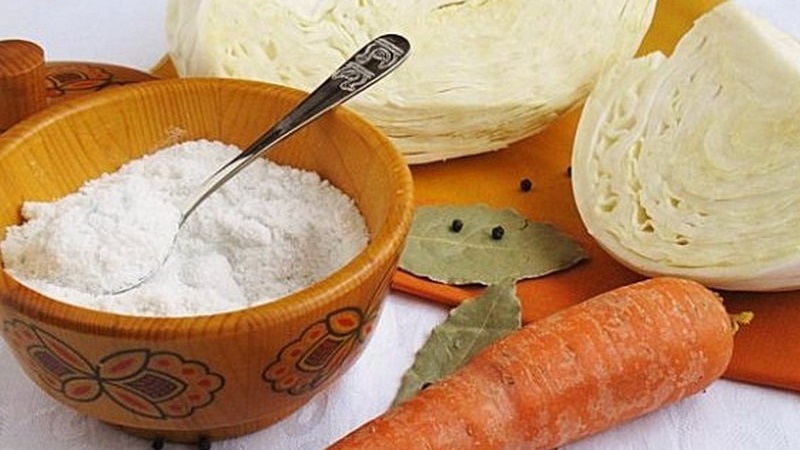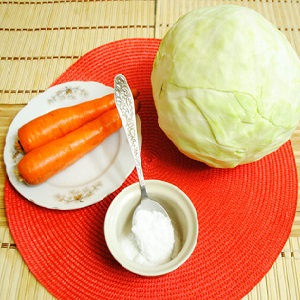How to calculate how much salt is needed for 1 kg of cabbage for pickling
Few people would refuse to try sauerkraut on a dinner or holiday table. This is a traditional dish that the whole family used to make.
In the modern world, housewives are also engaged in pickling cabbage, but they do not always observe the correct proportions of ingredients. Therefore, we analyzed different recipes for the dish and found out how much salt is needed for 1 kg of cabbage for pickling.
The content of the article
How much salt is needed for 1 kg of cabbage when fermenting
If you look into old notebooks and notebooks with grandmother's recipes, which many have stored in the kitchen, you can see the proportion: for 1 kg of cabbage, take 25 g of salt.
In 1 st. l. 30 g of salt is placed with a slide, and without a slide it will be about 25 g... You can measure it the old fashioned way, with spoons, but it is better to use a kitchen scale.
According to the recipe, the bottom of the prepared dishes is covered with a layer of rye flour.then topped with whole cabbage leaves. For taste, add carrots or apples, lingonberries or cranberries. Next, spread the chopped cabbage, pre-mixed with salt. A circle is laid on top (a plate or a wooden cutting board), and then the load is installed.

Modern recipe books also say that for 1 kg of vegetable, you need to take 25 g of salt. Over time, the proportions have not changed, the dish turns out to be delicious, like in ancient times. In such recipes, it is suggested to chop the cabbage into strips 0.5 cm wide and grind it with salt. Place whole cabbage leaves on the bottom, and chopped leaves on top, until the container is full.
However in the brochure Our Kitchen. Pickles and marinades "there is another advice: take 18-20 g of salt for 1 kg of cabbage... The vegetable is recommended to be chopped or chopped (optional), mixed with salt. For taste, add carrots at the rate of 100 g per 1 kg of cabbage. Put the prepared vegetables in a wide container, and install a press on top. Leave for three days at room temperature, then stir and place in a cold place.
For 10 kg of cabbage
Based on the recommended proportions, the consumption for salting 10 kg of sauerkraut will be 250 g of salt (10 tbsp. l. without a slide).
How salt consumption changes depending on the recipe
There is one rule in sauerkraut: The ratio of salt to vegetables is approximately 3%.
If you prefer lightly salted cabbage, you should take a smaller amount and vice versa, if you prefer highly salted cabbage - more.
What salt to choose
Grocery store shelves are full of variety types of salt: seafood, iodized, Himalayan, etc. But which one is most suitable for pickling cabbage? We will answer this question in detail.
Food
The best option for pickling cabbage - using common table salt. It comes without any additives and is sold at any grocery store at an affordable price. It is taken at the rate of 25 g per 1 kg of cabbage.

Marine
Edible salt is good for pickling cabbage, but it is a preservative... To enrich the dish with vitamins and minerals, seafood is used in cooking. It contains more than 40 units of micro and macro elements. It gives the ready-made sauerkraut a crispy taste and prevents over-acidification.
The taste of the finished dish does not depend on the grinding, so you can take any of the options.
Iodized
Iodized salt differs from others in that iodine is artificially added to it.
This is not recommended for pickling cabbage.... Iodine prevents the development of lactic acid bacteria, which are needed for the dish to have a sour taste, not spoil, and the finished sauerkraut - crunchy.
Grinding
Salt is divided into two groups depending on grinding: large and small. The quality of the workpieces depends on the grinding.
Stone (large)
 This type is the most common... Its deposits are found in most countries.
This type is the most common... Its deposits are found in most countries.
Most often, salt is mined underground, at a depth of 1000 m. The mined giant blocks are crushed with combines and crystals of the required size are obtained. The largest crystals are used for production purposes, and the smallest ones are used in cooking.
This salt contains a minimum amount of impurities and practically no moisture, which gives the substance a rich and pronounced taste.
Reference. Coarse (rock) salt is almost 100% sodium chloride.
Extra (small)
This salt is obtained from rock salt, bleached with aluminum hydroxide and potassium ferrocyanide... These substances are necessary to prevent the formation of lumps.
Extra not recommended for use in sourdough... It can form poisonous gas in contact with water.
Selection of suitable containers
For fermentation use different types of containers:
- Glass jar - in the case of small portions of blanks.
- Enamelled saucepan or bucket - for an average volume of workpieces. It is important that the container does not have damage to the enamel, otherwise this will lead to damage to the product.
- Earthenware or ceramic. This type of crockery must be covered with glaze.
- Wooden tub, keg - a classic container for pickling.
It is not recommended to use plastic dishes.
How to ferment cabbage in the classic way
Before you start cooking, you need to properly prepare the vegetables. Carrots are added to add sweetness and a pleasant orange hue, but you can do without it. Usually it is taken at the rate of about 60 g per 1 kg.
Procurement rules:
- rinse and dry vegetables and containers thoroughly;
- use coarse salt;
- crush with a wooden crush;
- during cooking, pierce with a wooden skewer;
- use oppression.

Sourdough instructions:
- Rinse the vegetables, chop in any convenient way. It is better to use a knife with a large wide blade, well sharpened so that there are no uncut leaves in the finished dish.
- Grate the carrots on a coarse grater.
- Put the cabbage in a wide saucepan, put the carrots on top.
- Then sprinkle with coarse salt.
- Rinse the vegetables with a wooden crush until the juice is released.
- Put another layer of cabbage, carrots and salt.
- Crush with a crush until juice is released.
- Cover with a suitable lid.
- Place the weight on top. This can be a glass jar filled with water.
Leave in this form for three days at room temperature... As soon as the salting begins to produce foam, remove the press and remove the lid. Take a wooden stick or skewer and pierce in several places. Repeat the procedure 2 times a day.
Important! Piercing the starter culture is necessary to release carbon dioxide. If you don't do this, the cabbage will turn out to be bitter and soft.
Arrange the finished salting in jars and put in a cool place... Serve with chopped onions, sprinkled with vegetable oil.
Conclusion
Sauerkraut contains vitamins that the body lacks so much in winter. It is important for novice housewives to know which salt to choose and how much to put in order to get delicious sauerkraut. Starting with a classic recipe for cooking, you can later diversify the table with cabbage snacks with cranberries or apples.